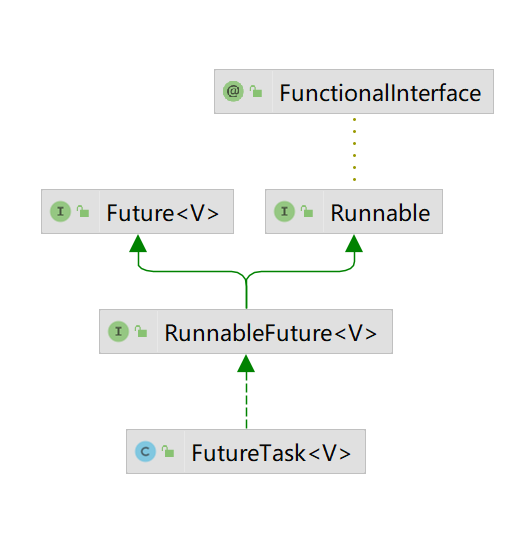在Java中,传统的线程模型通过Runnable或Thread实现,但缺乏获取执行结果的机制。为此,Java引入了Callable与Future接口,以及更先进的CompletableFuture类,以支持有返回结果的异步任务执行与复杂的任务编排。本文将探讨如何使用这些接口及类来优化异步编程模型。
1 获取异步结果
直接继承Thread或者实现Runnable接口都可以创建线程,但是这两种方法都有一个问题就是:没有返回值,也就是不能获取执行完的结果。因此java1.5就提供了Callable接口来实现这一场景,并配合Future和FutureTask来使用。
1.1 Callable
Runnable是一个接口,在它里面只声明了一个run()方法,由于run()方法返回值为void类型,所以在执行完任务之后无法返回任何结果。而Callable位于java.util.concurrent包下,它也是一个接口,在它里面声明了一个call()方法,这是一个泛型接口,call()函数返回的类型就是传递进来的V类型。
@FunctionalInterface
public interface Runnable {
public abstract void run();
}
@FunctionalInterface
public interface Callable<V> {
V call() throws Exception;
}
1.2 Future
Future就是对于具体的Callable任务的执行结果进行取消、查询是否完成、获取结果。必要时可以通过get方法获取执行结果,该方法会阻塞直到任务返回结果。
- boolean cancel (boolean mayInterruptIfRunning):取消任务的执行。参数指定是否立即中断任务执行,或者等等任务结束。
- boolean isCancelled ():任务是否已经取消,任务正常完成前将其取消,则返回 true。
- boolean isDone ():任务是否已经完成。需要注意的是如果任务正常终止、异常或取消,都将返回true。
- V get () throws InterruptedException, ExecutionException:等待任务执行结束,然后获得V类型的结果。InterruptedException 线程被中断异常, ExecutionException任务执行异常,如果任务被取消,还会抛出CancellationException。
- V get (long timeout, TimeUnit unit) throws InterruptedException, ExecutionException, TimeoutException:同上面的get功能一样,多了设置超时时间。参数timeout指定超时时间,uint指定时间的单位,在枚举类TimeUnit中有相关的定义。如果计算超时,将抛出TimeoutException。
1.3 FutureTask
但是Future只是一个接口,是无法直接用来创建对象使用的,因此就有了FutureTask。FutureTask类实现了RunnableFuture接口,RunnableFuture继承了Runnable接口和Future接口,所以它既可以作为Runnable被线程执行,又可以作为Future得到Callable的返回值。

要想运行Callable方法,但是Thread不支持构造方法中传递Callable的实例,因此我们需要通过FutureTask把一个Callable包装成Runnable,然后再通过这个FutureTask拿到Callable运行后的返回值。
FutureTask task = new FutureTask(new Callable() {
@Override
public Object call() throws Exception {
System.out.println("通过Callable方式执行任务");
Thread.sleep(3000);
return "返回任务结果";
}
});
new Thread(task).start();
System.out.println(task.get());
public class FutureTaskDemo {
public static void main(String[] args) throws ExecutionException, InterruptedException {
Task task = new Task();
//构建futureTask
FutureTask<Integer> futureTask = new FutureTask<>(task);
//作为Runnable入参
new Thread(futureTask).start();
System.out.println("task运行结果:"+futureTask.get());
}
static class Task implements Callable<Integer> {
@Override
public Integer call() throws Exception {
System.out.println("子线程正在计算");
int sum = 0;
for (int i = 0; i < 100; i++) {
sum += i;
}
return sum;
}
}
}
从本质上说,Future表示一个异步计算的结果。它提供了isDone()来检测计算是否已经完成,并且在计算结束后,可以通过get()方法来获取计算结果。在异步计算中,Future确实是个非常优秀的接口。但是,它的本身也确实存在着许多限制:
- 并发执行多任务:Future只提供了get()方法来获取结果,并且是阻塞的。所以,除了等待你别无他法;
- 无法对多个任务进行链式调用:如果希望在计算任务完成后执行特定动作,比如发邮件,但Future却没有提供这样的能力;
- 无法组合多个任务:如果你运行了10个任务,并期望在它们全部执行结束后执行特定动作,那么在Future中这是无能为力的;
- 没有异常处理:Future接口中没有关于异常处理的方法;
2 异步任务编排CompletableFuture
为了方便地处理多个任务的依赖关系、进行异常处理等,Java引入了CompletableFuture类,它不仅提供了更多实用的方法,还支持任务之间的编排。
2.1 创建异步操作
CompletableFuture 提供了多种静态方法来创建异步操作:
CompletableFuture<Void> runAsync(Runnable runnable);
CompletableFuture<Void> runAsync(Runnable runnable, Executor executor);
CompletableFuture<U> supplyAsync(Supplier<U> supplier);
CompletableFuture<U> supplyAsync(Supplier<U> supplier, Executor executor);
这四个方法区别在于:
- runAsync 方法以Runnable函数式接口类型为参数,没有返回结果,supplyAsync 方法Supplier函数式接口类型为参数,返回结果类型为U;Supplier 接口的 get() 方法是有返回值的(会阻塞)
- 没有指定Executor的方法会使用ForkJoinPool.commonPool() 作为它的线程池执行异步代码。如果指定线程池,则使用指定的线程池运行。
- 默认情况下 CompletableFuture 会使用公共的 ForkJoinPool 线程池,这个线程池默认创建的线程数是 CPU 的核数(也可以通过 JVM option:-Djava.util.concurrent.ForkJoinPool.common.parallelism 来设置 ForkJoinPool 线程池的线程数)。如果所有 CompletableFuture 共享一个线程池,那么一旦有任务执行一些很慢的 I/O 操作,就会导致线程池中所有线程都阻塞在 I/O 操作上,从而造成线程饥饿,进而影响整个系统的性能。所以,强烈建议你要根据不同的业务类型创建不同的线程池,以避免互相干扰。
2.2 获取结果
join()和get()方法都是用来获取CompletableFuture异步之后的返回值。join()方法抛出的是uncheck异常(即未经检查的异常),不会强制开发者抛出。get()方法抛出的是经过检查的异常,ExecutionException, InterruptedException 需要用户手动处理(抛出或者 try catch)
2.3 结果处理
当CompletableFuture的计算结果完成,或者抛出异常的时候,我们可以执行特定的 Action。主要是下面的方法:
public CompletableFuture<T> whenComplete(BiConsumer<? super T,? super Throwable> action);
public CompletableFuture<T> whenCompleteAsync(BiConsumer<? super T,? super Throwable> action);
public CompletableFuture<T> whenCompleteAsync(BiConsumer<? super T,? super Throwable> action, Executor executor);
public CompletableFuture<T> exceptionally(Function<Throwable,? extends T> fn);
- Action的类型是BiConsumer,它可以处理正常的计算结果,或者异常情况。
- 方法不以Async结尾,意味着Action使用相同的线程执行,而Async可能会使用其它的线程去执行(如果使用相同的线程池,也可能会被同一个线程选中执行)。
- 这几个方法都会返回CompletableFuture,当Action执行完毕后它的结果返回原始的CompletableFuture的计算结果或者返回异常
2.4 结果转换
所谓结果转换,就是将上一段任务的执行结果作为下一阶段任务的入参参与重新计算,产生新的结果。
2.4.1 thenApply
thenApply 接收一个函数作为参数,使用该函数处理上一个CompletableFuture 调用的结果,并返回一个具有处理结果的Future对象。
public <U> CompletableFuture<U> thenApply(Function<? super T,? extends U> fn)
public <U> CompletableFuture<U> thenApplyAsync(Function<? super T,? extends U> fn)
public <U> CompletableFuture<U> thenApplyAsync(Function<? super T,? extends U> fn, Executor executor)
2.4.2 thenCompose
thenCompose 的参数为一个返回 CompletableFuture 实例的函数,该函数的参数是先前计算步骤的结果.
public <U> CompletableFuture<U> thenCompose(Function<? super T, ? extends CompletionStage<U>> fn);
public <U> CompletableFuture<U> thenComposeAsync(Function<? super T, ? extends CompletionStage<U>> fn) ;
public <U> CompletableFuture<U> thenComposeAsync(Function<? super T, ? extends CompletionStage<U>> fn, Executor executor) ;
2.5 结果消费
与结果处理和结果转换系列函数返回一个新的 CompletableFuture 不同,结果消费系列函数只对结果执行Action,而不返回新的计算值。根据对结果的处理方式,结果消费函数又分为:
- thenAccept系列:对单个结果进行消费
- thenAcceptBoth系列:对两个结果进行消费
- thenRun系列:不关心结果,只对结果执行Action
2.5.1 thenAccept
通过观察该系列函数的参数类型可知,它们是函数式接口Consumer,这个接口只有输入,没有返回值。
public CompletionStage<Void> thenAccept(Consumer<? super T> action);
public CompletionStage<Void> thenAcceptAsync(Consumer<? super T> action);
public CompletionStage<Void> thenAcceptAsync(Consumer<? super T> action,Executor executor);
2.5.2 thenAcceptBoth
thenAcceptBoth 函数的作用是,当两个 CompletionStage 都正常完成计算的时候,就会执行提供的action消费两个异步的结果。
public <U> CompletionStage<Void> thenAcceptBoth(CompletionStage<? extends U> other,BiConsumer<? super T, ? super U> action);
public <U> CompletionStage<Void> thenAcceptBothAsync(CompletionStage<? extends U> other,BiConsumer<? super T, ? super U> action);
public <U> CompletionStage<Void> thenAcceptBothAsync(CompletionStage<? extends U> other,BiConsumer<? super T, ? super U> action, Executor executor);
2.5.3 thenRun
thenRun 也是对线程任务结果的一种消费函数,与thenAccept不同的是,thenRun 会在上一阶段 CompletableFuture 计算完成的时候执行一个Runnable,Runnable并不使用该 CompletableFuture 计算的结果。
public CompletionStage<Void> thenRun(Runnable action);
public CompletionStage<Void> thenRunAsync(Runnable action);
public CompletionStage<Void> thenRunAsync(Runnable action,Executor executor);
2.6 结果组合
2.6.1 thenCombine
thenCombine 方法,合并两个线程任务的结果,并进一步处理。
public <U,V> CompletionStage<V> thenCombine(CompletionStage<? extends U> other,BiFunction<? super T,? super U,? extends V> fn);
public <U,V> CompletionStage<V> thenCombineAsync(CompletionStage<? extends U> other,BiFunction<? super T,? super U,? extends V> fn);
public <U,V> CompletionStage<V> thenCombineAsync(CompletionStage<? extends U> other,BiFunction<? super T,? super U,? extends V> fn,Executor executor);
2.7 任务交互
所谓线程交互,是指将两个线程任务获取结果的速度相比较,按一定的规则进行下一步处理。
2.7.1 applyToEither
两个线程任务相比较,先获得执行结果的,就对该结果进行下一步的转化操作。
public <U> CompletionStage<U> applyToEither(CompletionStage<? extends T> other,Function<? super T, U> fn);
public <U> CompletionStage<U> applyToEitherAsync(CompletionStage<? extends T> other,Function<? super T, U> fn);
public <U> CompletionStage<U> applyToEitherAsync(CompletionStage<? extends T> other,Function<? super T, U> fn,Executor executor);
2.7.2 acceptEither
两个线程任务相比较,先获得执行结果的,就对该结果进行下一步的消费操作。
public CompletionStage<Void> acceptEither(CompletionStage<? extends T> other,Consumer<? super T> action);
public CompletionStage<Void> acceptEitherAsync(CompletionStage<? extends T> other,Consumer<? super T> action);
public CompletionStage<Void> acceptEitherAsync(CompletionStage<? extends T> other,Consumer<? super T> action,Executor executor);
2.7.3 runAfterEither
两个线程任务相比较,有任何一个执行完成,就进行下一步操作,不关心运行结果。
public CompletionStage<Void> runAfterEither(CompletionStage<?> other,Runnable action);
public CompletionStage<Void> runAfterEitherAsync(CompletionStage<?> other,Runnable action);
public CompletionStage<Void> runAfterEitherAsync(CompletionStage<?> other,Runnable action,Executor executor);
2.7.4 runAfterBoth
两个线程任务相比较,两个全部执行完成,才进行下一步操作,不关心运行结果。
public CompletionStage<Void> runAfterBoth(CompletionStage<?> other,Runnable action);
public CompletionStage<Void> runAfterBothAsync(CompletionStage<?> other,Runnable action);
public CompletionStage<Void> runAfterBothAsync(CompletionStage<?> other,Runnable action,Executor executor);
2.7.5 anyOf
anyOf 方法的参数是多个给定的 CompletableFuture,当其中的任何一个完成时,方法返回这个 CompletableFuture。
public static CompletableFuture<Object> anyOf(CompletableFuture<?>... cfs);
2.7.6 allOf
allOf方法用来实现多 CompletableFuture 的同时返回。
public static CompletableFuture<Void> allOf(CompletableFuture<?>... cfs);
3 结语
综上所述,Java中的Future与FutureTask为异步任务执行提供了基础框架,但其功能较为有限。为了解决这些问题,Java引入了CompletableFuture,它不仅简化了异步编程模型,还增强了任务调度与组合的能力。通过CompletableFuture,开发者能够更加灵活地管理非阻塞操作,处理并发执行的多个任务,并优雅地应对异步编程中的各种挑战。这使得Java应用程序在处理高性能和高并发场景时更为强大和高效。